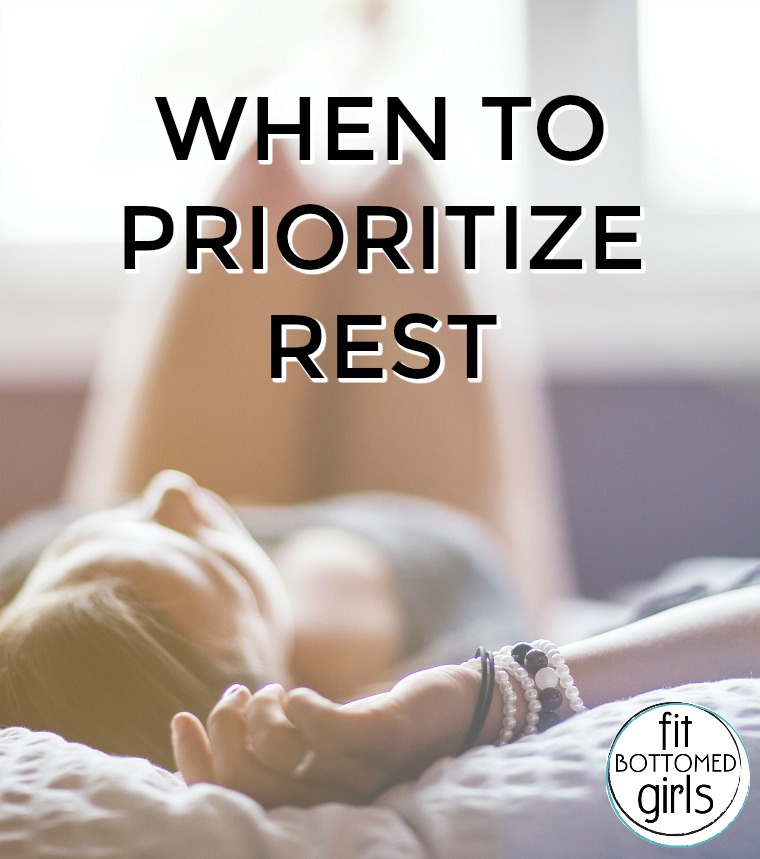When to Prioritize Rest

To work out or not to work out … sometimes that’s a legitimate question you have to ask yourself.
Much of the time the answer lingers somewhere in the gray area but with experience you get better at figuring out what the right answer is for you. However, there are circumstances when you absolutely should prioritize rest over a workout.
While I fully endorse consistent badassery as a means to reach your goals, here’s a breakdown of a few times when less is definitely more.
I’m not sure if this is a cold or if I’ve contracted the plague. With colds, I generally follow the “above-your-neck rule” — if your symptoms are all above your neck (runny nose or sneezing), you should be fine to do low- to moderate-intensity exercise, but if any of your symptoms are below your neck (chest congestion, fever, etc.), rest. Higher intensity workouts have been shown to negatively impact immune system functioning, which could mean that you’re sick for longer. Also, no one else wants your cold, so maybe skip spreading your germs by showing up for a group class or touching all the gym equipment.
I’m so tired I can’t even. It may seem noble to drag yourself out of bed every morning to go to your workouts but sometimes it’s counter-productive. Whether your exhaustion is due to work, home stuff or overtraining, dragging yourself through workouts is a recipe for disaster and places your already stressed-out body under more stress and that’s just mean. Chronic fatigue can be an important signal that something’s wrong — either with your health or your schedule. Light movement can be helpful in getting your energy levels up, but skip the high-intensity stuff … your body will thank you. Not wanting to get out of bed because it’s so cozy under your blanket that you don’t want to move is an excuse; not wanting to move because you can’t physically pry your eyes open is a completely different thing.
Lunch? Ain’t nobody got time for that. Look, stuff happens. We all have those times when lunch hour is a luxury we just don’t have. Maybe you’ve been running all over, barely eating or drinking for the better part of the day. You’re not doing yourself any favors by taking a starving, depleted and dehydrated body to a workout. Instead, use the time to replenish so you can get back to your workouts tomorrow. The same applies for times when you’ve had a stomach thing that prevents you from being able to eat properly and stay adequately hydrated — even after the nausea and squirrelly stomach go away, your essential organs (heart and lungs) need calories, nutrients and water to operate efficiently. Cut the intensity of your workouts way back for a while to allow your body to catch up.
I’ve got this “knee (or other body part) thing” happening. If you’ve got an injured or tweaky body part, it’s time to rest it. There is nothing to be gained from pushing your injured parts through yet another workout. They aren’t going to suddenly and spontaneously heal because you insisted that they keep going when they don’t want to. Take a few workouts off (or do something that doesn’t require that part of your body to work for a while) so that you don’t have to be out of commission for weeks later on. My general rule of thumb is that if three days of rest doesn’t make it feel better then it’s time to see a doctor.
I’ve been totally killing it in the gym lately. In order to maintain higher intensity during your workouts, you need to rest so that your body can rally for the next workout without breaking down. If you’ve been following a progressive program, increasing your training volume or smashing PRs in the gym, it’s important to cut back every few weeks to give your body a chance to catch up and adapt to the work. Without a lighter week in there every once in a while, the risk is that you’ll eventually out-train your body’s ability to self-heal — which can lead to frustrating plateaus, burnout and overuse injuries.
Ouchie, my everything hurts. It’s totally normal to experience some delayed onset muscle soreness (DOMS) a day or two after a tough workout. But if you can’t move your joints through their full range of motion smoothly and without pain, skip it. Doing otherwise can cause you to compromise form which wreaks havoc on your joints, ligaments and tendons. Use the time to let your body repair and rebuild so it gets stronger rather than breaking down — risking longer stretches of time off due to an injury.
When do you know it’s time to rest? —Alison

Comments
Overtraining is definitely an issue a lot of people face I believe when they’re trying to lose weight. Great post!
Scheduling in rest is just as important as scheduling cardio, long runs, short runs, arms, legs, etc. If you wait until you start feeling the signs, you risk getting injured or burned out. Being motivated is a great thing, but being smart is even better!
I’m feeling the ouchie, everything hurts right about now
Comments are closed.